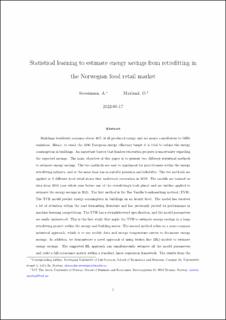| dc.contributor.author | Severinsen, Alexander | |
| dc.contributor.author | Myrland, Øystein | |
| dc.date.accessioned | 2023-03-07T10:41:08Z | |
| dc.date.available | 2023-03-07T10:41:08Z | |
| dc.date.created | 2022-06-17T10:09:27Z | |
| dc.date.issued | 2022 | |
| dc.identifier.citation | Renewable and Sustainable Energy Reviews. 2022, 167. | en_US |
| dc.identifier.issn | 1364-0321 | |
| dc.identifier.uri | https://hdl.handle.net/11250/3056381 | |
| dc.description.abstract | Buildings worldwide consume about 40% of all produced energy and are major contributors to GHG emissions. Hence, to reach the 2030 European energy efficiency target it is vital to reduce the energy consumption in buildings. An important barrier that hinders renovation projects is uncertainty regarding the expected savings. The main objective of this paper is to present two different statistical methods to estimate energy savings. The two methods are easy to implement for practitioners within the energy retrofitting industry, and at the same time has acceptable precision and reliability. The two methods are applied at 5 different food retail stores that undertook renovation in 2019. The models are trained on data from 2018 (one whole year before any of the retrofitting's took place) and are further applied to estimate the energy savings in 2021. The first method is the Tao Vanilla benchmarking method (TVB). The TVB model predict energy consumption in buildings on an hourly level. The model has received a lot of attention within the load forecasting literature and has previously proved its performance in machine learning competitions. The TVB has a straightforward specification, and the model parameters are easily understood. This is the first study that apply the TVB to estimate energy savings in a large retrofitting project within the energy and building sector. The second method relies on a more common industrial approach, which is to use weekly data and energy temperature curves to document energy savings. In addition, we demonstrate a novel approach of using broken line (BL) models to estimate energy savings. The suggested BL approach can simultaneously estimate all the model parameters and yield a full covariance matrix within a standard linear regression framework. The results from the retrofitting projects demonstrates considerable energy savings between 25% and 55%. Furthermore, both the TVB and the BL models deliver reliable precision. The estimated energy savings from both models are coinciding. This indicates that they could jointly be used to gain insight that may lead to more informed decisions for energy saving projects. The TVB model proves to be a proficient benchmarking model that can give detailed hourly information about the savings. The BL model is used to gain intrinsic details about the buildings varying cooling and heating needs depending on the outside temperature during the year. | |
| dc.language.iso | eng | en_US |
| dc.title | Statistical learning to estimate energy savings from retrofitting in the Norwegian food retail market | en_US |
| dc.title.alternative | Statistical learning to estimate energy savings from retrofitting in the Norwegian food retail market | en_US |
| dc.type | Journal article | en_US |
| dc.type | Peer reviewed | en_US |
| dc.description.version | acceptedVersion | |
| dc.source.volume | 167 | en_US |
| dc.source.journal | Renewable & Sustainable Energy Reviews | en_US |
| dc.identifier.doi | 10.1016/j.rser.2022.112691 | |
| dc.identifier.cristin | 2032766 | |
| cristin.ispublished | true | |
| cristin.fulltext | postprint | |
| cristin.qualitycode | 1 | |
